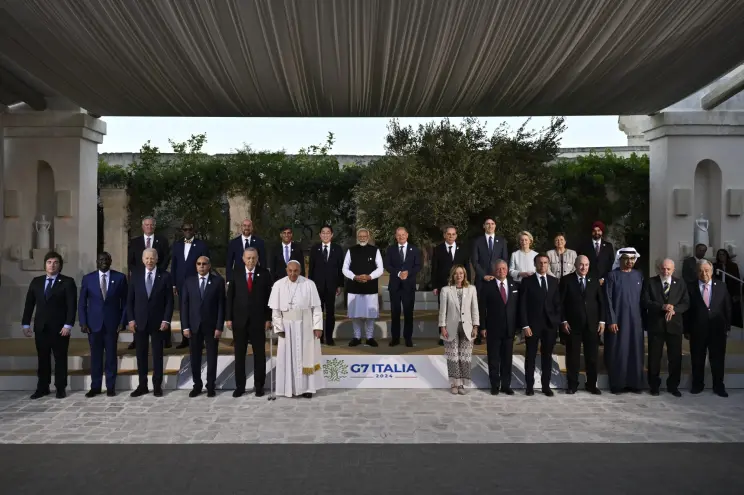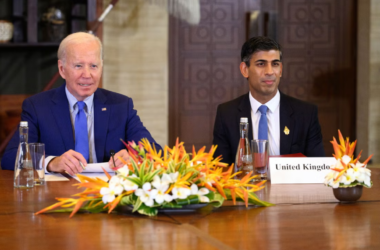The Group of Seven (G7) Summit ended on Saturday with member nations struggling to align their diverse strategic interests, leaving the future trajectory of their decisions uncertain. This year’s summit, attended by leaders from Canada, France, Germany, Italy, Japan, the United Kingdom, and the United States, saw heated debates particularly around the joint communique issued on Friday.
Contentious Joint Communique
The communique, released on Friday, became a focal point of contention among the G7 members. Central to the debates was a proposed deal to use the interest accrued from frozen Russian assets to finance a $50 billion loan package for Ukraine. This measure, criticized by Russian President Vladimir Putin as “theft,” remains controversial and faces an unclear path forward, as member states continue to differ on the specifics and execution of the plan.
U.S. and Ukraine Security Pact
In parallel, the United States announced a separate security agreement with Ukraine during the summit. However, political analysts caution that this agreement may face challenges, particularly in light of the approaching U.S. presidential election. President Joe Biden, who brokered the deal, is contending with a potentially tough re-election campaign against former President Donald Trump, whose stance on Ukraine differs significantly from Biden’s.
Shifting Global Influence
The summit also highlighted the G7’s grappling with its waning influence in a rapidly evolving global landscape. Leaders from emerging economies, including India, South Africa, and Brazil, were present at the summit, underscoring a broader global context. Critics argue that the G7, which represents less than 10 percent of the world’s population, struggles to maintain its relevance amid economic stagnation compared to the higher growth rates of emerging markets.
Experts like Alberto Bradanini, chairman of the Contemporary China Study Center in Italy, suggest that the G7’s actions, including selectively inviting BRICS nations, reveal a reluctance to fully engage with the broader international community, leading to tensions rather than cooperation.
Internal Political Pressures
Internal political dynamics among G7 nations further complicated consensus-building. The summit took place against the backdrop of political challenges in several member countries. The summit occurred amid significant political challenges for several G7 leaders. Recent European Parliament elections resulted in setbacks for governing parties in multiple member states. German Chancellor Olaf Scholz’s Social Democratic Party saw record-low vote shares, while French President Emmanuel Macron faced the possibility of new legislative elections after losses to far-right opponents.
In the UK, Prime Minister Rishi Sunak announced a snap general election scheduled for July 4, as his Conservative Party struggles to maintain its prolonged tenure in power. Canadian Prime Minister Justin Trudeau, dealing with a series of scandals, is set to host next year’s G7 summit amid an anticipated difficult electoral campaign. Meanwhile, Japanese Prime Minister Fumio Kishida is grappling with historically low approval ratings.
In contrast, Italy’s Prime Minister Giorgia Meloni, whose arch-conservative Brothers of Italy party increased its share of the vote in the European parliamentary elections, saw a rise in her domestic political standing, emboldening her to push for national priorities such as migration and African policy at the summit.
Divergent Approaches to AI Governance
Another key topic at the summit was the governance of artificial intelligence. Member states debated the balance between fostering innovation and mitigating the potential risks of AI. European Union countries advocated for stringent regulations, emphasizing a legally binding framework to ensure ethical and secure AI development. In contrast, the United States preferred a more flexible, market-driven approach.
The communique emphasized a commitment to “safe, secure, and trustworthy AI,” but acknowledged that G7 members might adopt varying approaches and policy instruments. This lack of a unified stance highlights the ongoing challenges in reaching a global consensus on AI governance.
Omission of Abortion Issue
The summit’s joint communique notably omitted any reference to abortion, despite it being a contentious issue among member states. Differences in national policies and perspectives on abortion rights led to its exclusion from the final document, reflecting the complexities of achieving alignment on social issues within the G7.
Conclusion
The G7 Summit concluded with significant unresolved debates and uncertainties. The differing strategic interests and internal political pressures among member nations highlighted the complexities in reaching a unified stance on global issues. As the G7 looks towards its next meeting, navigating these divergent perspectives will be crucial for its continued relevance and effectiveness in addressing global challenges.








